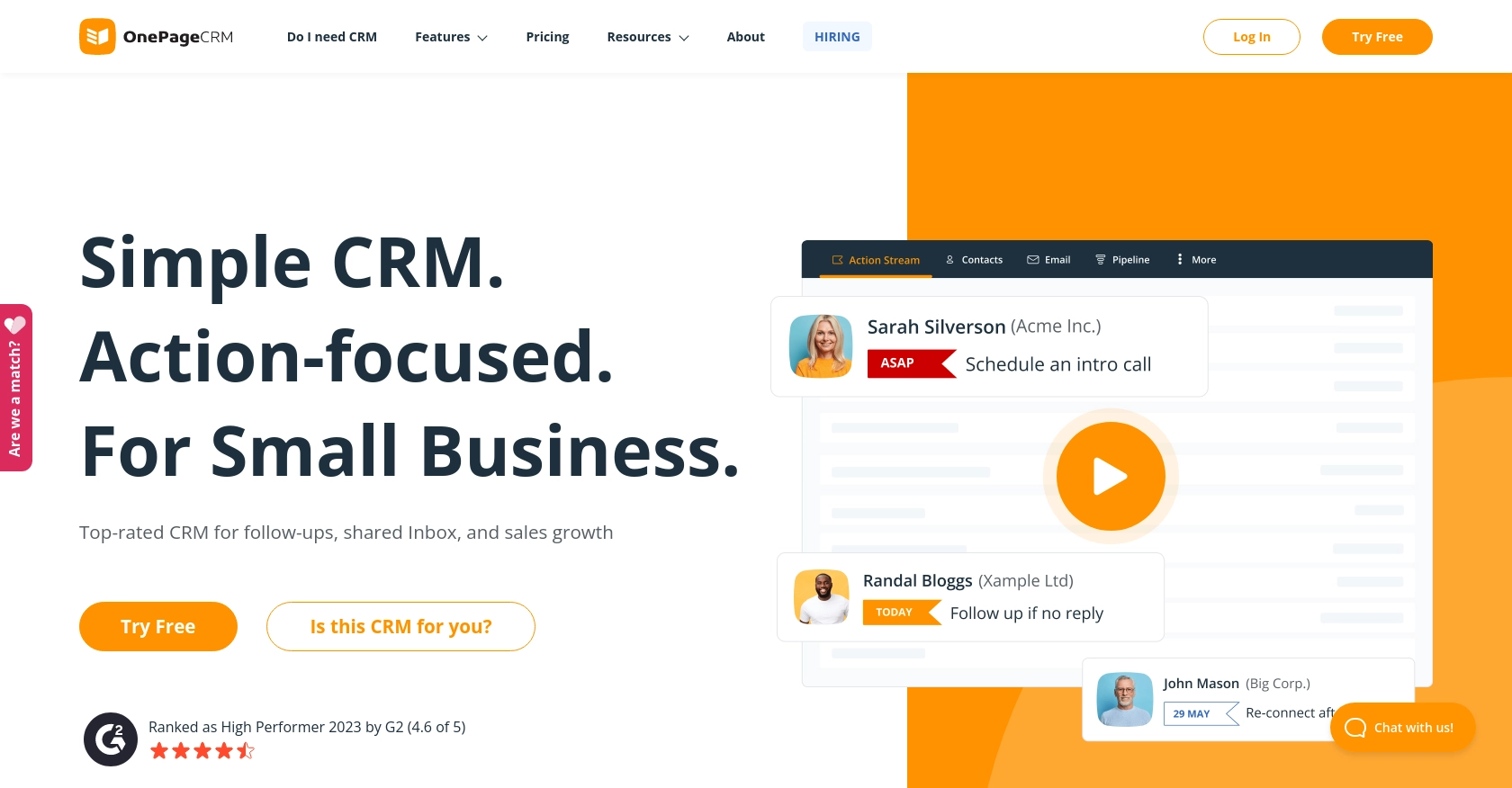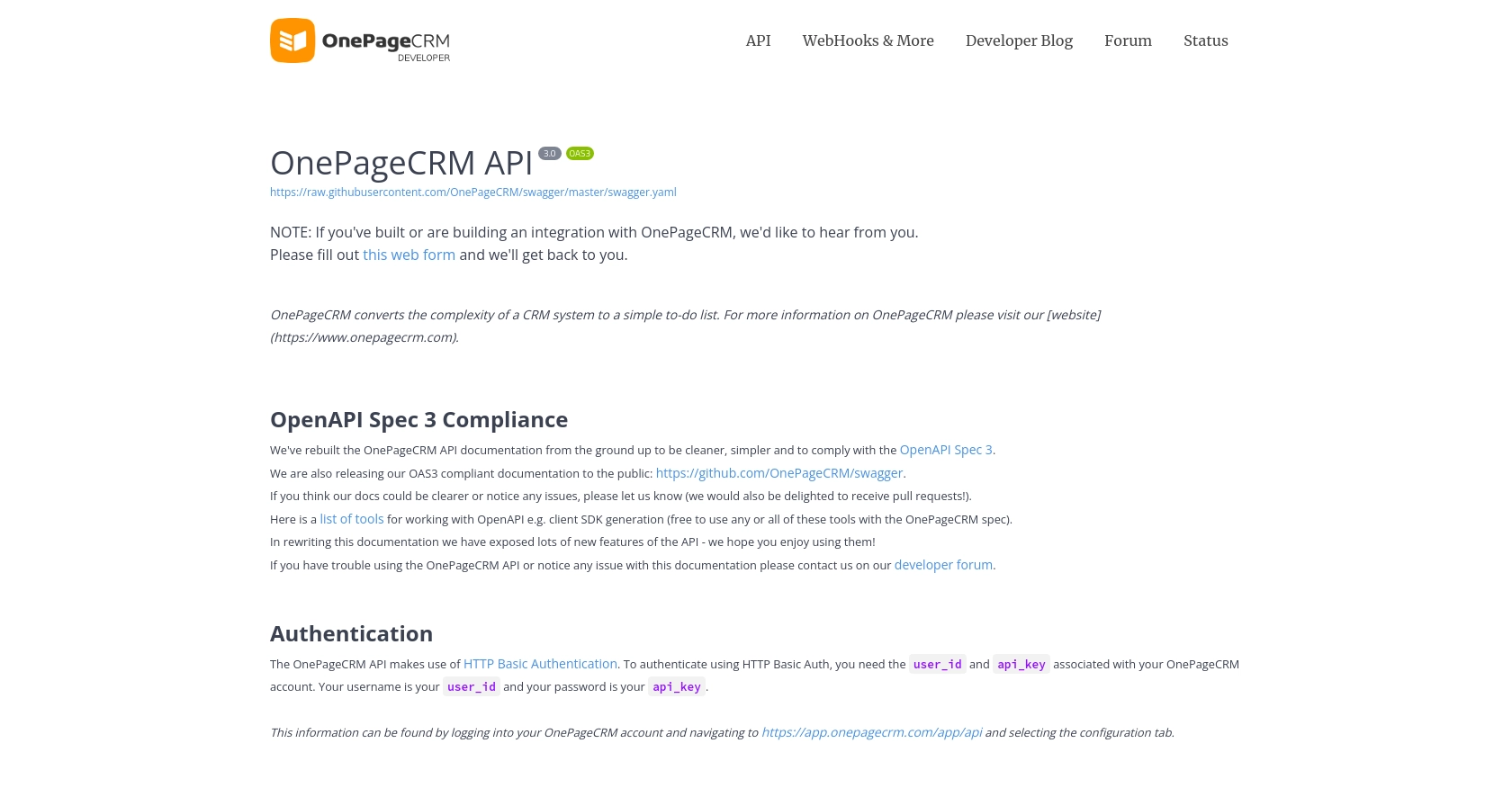Using the OnePageCRM API to Get Users in Python

Introduction to OnePageCRM
OnePageCRM is a dynamic customer relationship management (CRM) platform designed to simplify sales processes for businesses. It offers a streamlined approach to managing customer interactions, focusing on actionable tasks that drive sales forward. With its intuitive interface and powerful features, OnePageCRM is a popular choice for sales teams looking to enhance productivity and efficiency.
Integrating with the OnePageCRM API allows developers to access and manage user data, facilitating seamless integration with other systems. For example, a developer might use the OnePageCRM API to retrieve a list of users within an organization, enabling synchronization of user data across multiple platforms. This can be particularly useful for maintaining up-to-date contact information and ensuring consistent user experiences across different applications.
Setting Up Your OnePageCRM Test Account
Before you can start using the OnePageCRM API, you'll need to set up a test account. This will allow you to safely experiment with API calls without affecting live data. Follow these steps to create a test account and obtain the necessary credentials for API access.
Creating a OnePageCRM Account
If you don't already have a OnePageCRM account, you can sign up for a free trial on their website. This trial will give you access to all the features you need to test the API integration.
- Visit the OnePageCRM website and click on the "Free Trial" button.
- Fill out the registration form with your details and submit it to create your account.
- Once your account is created, log in to access the OnePageCRM dashboard.
Generating API Credentials for OnePageCRM
To interact with the OnePageCRM API, you'll need to generate API credentials. These credentials will include a client ID and client secret, which are necessary for authenticating your API requests.
- Navigate to the "Settings" section in your OnePageCRM dashboard.
- Under "Integrations," find the "API" section and click on it.
- Follow the instructions to create a new API application. You will be provided with a client ID and client secret.
- Store these credentials securely, as you will need them to authenticate your API requests.
Understanding OnePageCRM's Custom Authentication
OnePageCRM uses a custom authentication method for API access. This involves using the client ID and client secret to obtain an access token, which is then used to authenticate API requests. Ensure that you handle these credentials securely and avoid exposing them in your code.
For more detailed information on authentication, refer to the OnePageCRM API documentation.

sbb-itb-96038d7
Making API Calls to Retrieve Users from OnePageCRM Using Python
To interact with the OnePageCRM API and retrieve user data, you'll need to set up your Python environment and write a script to make the necessary API calls. This section will guide you through the process, including setting up your environment, writing the code, and handling potential errors.
Setting Up Your Python Environment for OnePageCRM API Integration
Before you begin, ensure that you have Python installed on your machine. This tutorial uses Python 3.11.1. Additionally, you'll need the requests library to handle HTTP requests.
- Install Python 3.11.1 from the official Python website if you haven't already.
- Open your terminal or command prompt and install the
requestslibrary using pip:
pip install requestsWriting the Python Script to Get Users from OnePageCRM
With your environment set up, you can now write a Python script to call the OnePageCRM API and retrieve user information. Create a file named get_onepagecrm_users.py and add the following code:
import requests
# Set the API endpoint and headers
base_url = "https://app.onepagecrm.com/api/v3/"
endpoint = "users"
url = f"{base_url}{endpoint}"
headers = {
"Authorization": "Bearer Your_Access_Token",
"Content-Type": "application/json"
}
# Make a GET request to the API
response = requests.get(url, headers=headers)
# Check if the request was successful
if response.status_code == 200:
data = response.json()
for user in data['data']:
print(f"User ID: {user['user']['id']}, Name: {user['user']['first_name']} {user['user']['last_name']}")
else:
print(f"Failed to retrieve users: {response.status_code} - {response.json().get('message')}")Replace Your_Access_Token with the access token obtained during the authentication setup.
Running the Script and Verifying the Output
To execute the script, run the following command in your terminal:
python get_onepagecrm_users.pyIf successful, the script will output a list of users from your OnePageCRM account. Verify the results by checking the user data in your OnePageCRM dashboard.
Handling Errors and Troubleshooting OnePageCRM API Calls
While making API calls, you may encounter errors. Here are some common error codes and their meanings:
- 400 Bad Request: The request was invalid. Check the request parameters and format.
- 401 Unauthorized: Authentication failed. Verify your access token.
- 403 Forbidden: You do not have permission to access the resource.
- 404 Resource Not Found: The requested resource does not exist.
- 500 Internal Server Error: An error occurred on the server. Try again later.
For more detailed error handling, refer to the OnePageCRM API documentation.
Conclusion and Best Practices for Using OnePageCRM API with Python
Integrating with the OnePageCRM API using Python provides a powerful way to manage and synchronize user data across platforms. By following the steps outlined in this guide, you can efficiently retrieve user information and ensure seamless integration with other systems.
Best Practices for Secure and Efficient OnePageCRM API Integration
- Secure Storage of Credentials: Always store your client ID, client secret, and access tokens securely. Consider using environment variables or secure vaults to prevent unauthorized access.
- Handle Rate Limiting: Be mindful of API rate limits to avoid disruptions. Implement retry logic with exponential backoff to handle rate limit errors gracefully.
- Data Transformation and Standardization: Ensure that the data retrieved from OnePageCRM is transformed and standardized to match the requirements of your application, maintaining consistency across platforms.
- Error Handling: Implement robust error handling to manage potential API call failures. Log errors for troubleshooting and provide meaningful feedback to users.
Enhance Your Integration Strategy with Endgrate
While integrating with OnePageCRM is a valuable step, managing multiple integrations can be complex and time-consuming. Endgrate offers a streamlined solution by providing a unified API endpoint that connects to various platforms, including OnePageCRM. This allows you to build once for each use case and leverage an intuitive integration experience for your customers.
Explore how Endgrate can save you time and resources by outsourcing integrations, enabling you to focus on your core product. Visit Endgrate to learn more about optimizing your integration strategy.
Read More
Ready to get started?
